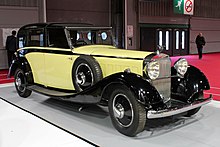Hispano-Suiza J12
| Hispano-Suiza J12 | |
|---|---|
 1933 Hispano-Suiza J12 Sport Torpedo | |
| Overview | |
| Manufacturer | Hispano-Suiza |
| Also called | |
| Production | 1931–1938 |
| Assembly |
|
| Designer |
|
| Body and chassis | |
| Class | Luxury car |
| Body style | by arrangement with the customer's coachbuilder |
| Layout | Front mid-engine, rear-wheel-drive |
| Powertrain | |
| Engine | |
| Transmission | 3-speed manual |
| Dimensions | |
| Wheelbase | |
| Chronology | |
| Predecessor | Hispano-Suiza H6[6] |
The Hispano-Suiza J12 is a luxury automobile that was made by Hispano-Suiza in France from 1931 to 1938.[5] It was the largest and most expensive car ever built by Hispano-Suiza.[2][3] It replaced the Hispano-Suiza H6.[6] The J12 was only available as a chassis, buyers having to arrange with an outside coachbuilder to add a body.[11]
Hispano-Suiza suspended automobile production in 1938 to concentrate on the manufacture of aircraft engines.[12][13]
Mechanical features
[edit]
The J12 was powered by a 60° V12 engine with pushrod-operated overhead valves and a seven-bearing crankshaft.[1] The engine initially displaced 9.4 L (574 cu in)[1][6] with bore and stroke both being 100 mm (3.9 in) and with a compression ratio of 5.0:1,[1] delivered 220 hp (160 kW) at 3000 rpm.[1][6] Two cars were fitted with long-stroke engines displacing 11.3 L (690 cu in) and delivering 250 hp (190 kW), and several J12s were later upgraded to the larger engine.[11] Each engine block was machined from a single 700 lb (318 kg) billet.[6]
To demonstrate the high quality engineering and reliability of the J12, one car was driven from Paris to Nice and back without needing oil or water.[11]
The J12 of the Spanish Head of State
[edit]In 1935 the Spanish Government placed an order for a J12 as ceremonial car for the President of the Republic. The body was to be a four-door convertible, built by Carrosserie Vanvooren of Paris. When the Spanish Civil War broke out in 1936, the bodied car was still in the French Hispano-Suiza plant, and in 1938 Miguel Mateu y Pla, one of the owners of the company, decided to deliver it to the Nationalists side. The car was then sent to the Fichet plant in Marseille to receive its armor plate and eventually delivered to the then new Spanish Government. It was first used by their Head of State, General Franco, in the Victory parade held in Madrid in May 19th, 1939.[14]
In 1952 this J12 was replaced by a Rolls-Royce Phantom IV. This was the only convertible out of the three Mulliner-bodied Phantom IV purchased by the Spanish Government; all of them are still in use in present days at the service of the Spanish royal family.
The J12 of the Shah Of Iran
[edit]Mohammad Reza Shah was given a J12 by his father in 1931 at the age of 12, right before taking part in Institut Le Rosey school in Switzerland.
Body was made by Paris-based body maker Carrosserie J. Saoutchik and used Swiss engineer Marc Birkigt's V12 engine.
Notes
[edit]- ^ a b c d e f g Rogliatti 1973, p. 77.
- ^ a b Kimes 1990, p. 646.
- ^ a b Nicholson 1982, p. 307.
- ^ a b Kimes 1990, p. 642.
- ^ a b Robson 1990, p. 72.
- ^ a b c d e f g h Scott 1991, p. 52.
- ^ a b c d Robson 2001, pp. 248–249.
- ^ Given as 134+1⁄2 in (3,420 mm) in Kimes 1990, p. 648
- ^ a b Kimes 1990, p. 648.
- ^ Given as 157+3⁄4 in (4,010 mm) in Kimes 1990, p. 648
- ^ a b c Cheetham, Craig (2004). Vintage Cars - The Finest Prewar Automobiles. Rochester, United Kingdom: Grange Books. p. 105. ISBN 1840136359.
- ^ Robson 1990, p. 73.
- ^ Kimes 1990, p. 651.
- ^ "El tipo 68". Automóviles Hispano-Suiza. Retrieved 31 January 2020.
References
[edit]- Kimes, Beverly Rae, ed. (1990). "Hispano-Suiza". The Classic Car. Des Plaines, IL US: Classic Car Club of America. pp. 641–651. ISBN 0-9627868-0-2. LCCN 90084421.
- Nicholson, T. R. (1982) [First edition 1968]. "Hispano-Suiza (ii) (F) 1911–1938". In Georgano, G. N. (ed.). The New Encyclopedia of Motorcars 1885 to the Present (Third ed.). New York, NY US: E. P. Dutton. p. 307. ISBN 0525932542. LCCN 81-71857.
- Robson, Graham (2001). "Hispano-Suiza V12". The Illustrated Directory of Classic Cars. St. Paul, MN USA: MBI Publishing. pp. 248–249. ISBN 0-7603-1049-1.[dead link]
- Robson, Graham (1990). "Hispano-Suiza V12". The Worlds Most Powerful Cars. 6 Blundell Street, London N7 9BH: Quintet Publishing. pp. 72–73. ISBN 1-85076-254-6.
{{cite book}}: CS1 maint: location (link) - Rogliatti, Gianni (1973). Posthumus, Cyril (ed.). Period Cars. Feltham, Middlesex, UK: Hamlyn. pp. 76–77. ISBN 0-600-33401-5.
- Scott, Michael G. H. (29 July 1991). "Escape Road: 1931-38 Hispano-Suiza Type 68 J12". AutoWeek. 41 (30). Detroit MI: Crain Communications: 52. ISSN 0192-9674.
